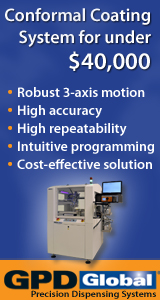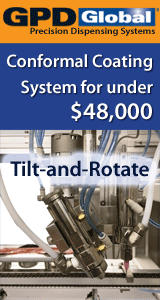Printed Circuit Board Assembly & PCB Design Forum
SMT electronics assembly manufacturing forum.
- SMTnet
- »
- Electronics Forum
- »
- Bottom side process question
Bottom side process question
![]() Anyone doing a print-dispense-place-reflow process? I've ne...
- Mar 13, 2001
by
Steve Thomas
Anyone doing a print-dispense-place-reflow process? I've ne...
- Mar 13, 2001
by
Steve Thomas
![]()
![]()
![]() Check Bob Willis' site. He calls this Single Side Multipass...
- Mar 14, 2001
by
davef
Check Bob Willis' site. He calls this Single Side Multipass...
- Mar 14, 2001
by
davef
![]()
![]()
![]() Some thing to watch out for is the cure spec for the adhesiv...
- Mar 14, 2001
by
Michael Parker
Some thing to watch out for is the cure spec for the adhesiv...
- Mar 14, 2001
by
Michael Parker
![]()
![]()
![]() Mike makes a very good [ no, make that excellent!!!] point a...
- Mar 14, 2001
by
davef
Mike makes a very good [ no, make that excellent!!!] point a...
- Mar 14, 2001
by
davef
![]()
![]()
![]() Like I said, I would only try this if I had some sort of rea...
- Mar 15, 2001
by
Steve Thomas
Like I said, I would only try this if I had some sort of rea...
- Mar 15, 2001
by
Steve Thomas
![]()
![]()
![]() That makes us almost even, Dave. I have a hard time believi...
- Mar 15, 2001
by
Steve Thomas
That makes us almost even, Dave. I have a hard time believi...
- Mar 15, 2001
by
Steve Thomas
![]()
![]()
![]() Don�t be afraid of the more standard doubles sided mixed pro...
- Mar 15, 2001
by
Travis Slaughter
Don�t be afraid of the more standard doubles sided mixed pro...
- Mar 15, 2001
by
Travis Slaughter
![]()
![]()
![]() The only way I know of waving the bottom side with SMT parts...
- Mar 15, 2001
by
Michael Parker
The only way I know of waving the bottom side with SMT parts...
- Mar 15, 2001
by
Michael Parker
![]()
![]()
![]() Like I said it was only a rumor I heard but intrigued me eno...
- Mar 15, 2001
by
Travis Slaughter
Like I said it was only a rumor I heard but intrigued me eno...
- Mar 15, 2001
by
Travis Slaughter
![]()
![]()
![]() Wazis havin' "a hard time believing half of what you say"? ...
- Mar 15, 2001
by
davef
Wazis havin' "a hard time believing half of what you say"? ...
- Mar 15, 2001
by
davef
![]()
![]()
![]() Shadowing sounds about right to me also. Really dicey experi...
- Mar 16, 2001
by
Michael Parker
Shadowing sounds about right to me also. Really dicey experi...
- Mar 16, 2001
by
Michael Parker
![]()
![]()
![]() We screen print epoxy adhesive, place components then run th...
- Mar 16, 2001
by
We screen print epoxy adhesive, place components then run th...
- Mar 16, 2001
by
![]()
![]() That's what we do also. It's the "print, dispense" sequence...
- Mar 16, 2001
by
davef
That's what we do also. It's the "print, dispense" sequence...
- Mar 16, 2001
by
davef
![]()
![]()
![]() Steve,
I did this several years ago on a terribly designed ...
- Mar 16, 2001
by
Frank
Steve,
I did this several years ago on a terribly designed ...
- Mar 16, 2001
by
Frank
![]()
- SMTnet
- »
- Electronics Forum
- »
- Bottom side process question







